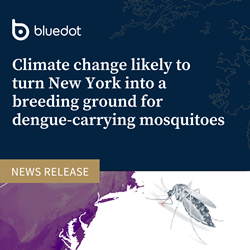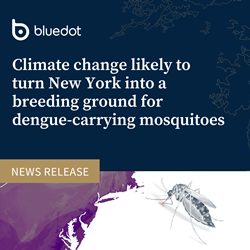
Greater awareness of this risk and earlier interventions are critical in mitigating against spread.
TORONTO (PRWEB)
February 21, 2023
BlueDot Inc., a leading artificial and human intelligence organization for detecting, assessing, and responding to global infectious disease threats, announced today that its latest forecasting models reveal that climate change is causing a major expansion of areas where Aedes (Ae.) genus mosquitoes could breed and survive over the next 10 years. These mosquitoes are known carriers for chikungunya, dengue, yellow fever and Zika, which are four of the most disruptive mosquito-borne diseases.
BlueDot data scientists have found that the Ae. albopictus and Ae. aegypti mosquitoes have the potential to expand upwards of 400 kilometers into the north, reaching major cities like Beijing, London, New York, and Toronto – potentially exposing over 40 million people* in these cities alone. Driven by factors like climate change, urbanization, and ecosystem disruption, mosquitoes have already begun to move beyond their traditional habitat and have been found in some of these regions**.
BlueDot had previously predicted the first outbreak of Zika virus in Florida, U.S. six months before it occurred. It also alerted its clients of COVID-19 nearly a week before the World Health Organization, and correctly identified many of the first international cities in which it would first emerge. To address the increasing frequency and severity of infectious diseases, BlueDot has brought in new data and scientific methods which allow for powerful analysis on changing seasonal disease spread.
“Greater awareness of this risk and earlier interventions are critical in mitigating against spread”, stated Dr. Andrea Thomas, Director of Epidemiology. “We’ve never before seen mosquitoes appear within these territories, at a rate where local infection is possible.”
BlueDot utilizes a gradient-boosted regression tree model to forecast global climatic suitability for Ae. albopictus and Ae. aegypti mosquitoes under the projected climate over the next 10 years with five-by-five-kilometre granularity. Precipitation, surface temperature, and elevation are used, along with historical mosquito occurrence data, to fit the models. They also evaluate three different climate scenarios which look at best-case, most-likely, and worse-case changes.
The results underline the need for education on mosquito-borne diseases, and procurement of medical and safety countermeasures such as insect repellant, removal of standing water, appropriate clothing or netting, and vaccinations (where applicable).
Further information on how the analysis was conducted can be found here (https://bluedot.global/anticipating-burden-of-disease-mosquito-borne-illness/) or via webinar here (https://bluedot.global/how-to-assess-burden-of-disease-na/).
*Sources: Based the combined estimated populations for Beijing, London, Toronto, and New York City
**Source: Windsor-Essex Health Unit
About BlueDot
BlueDot’s intelligence platform empowers public and private sector organizations to rapidly identify, understand, and effectively respond to global biothreats. Combining human and artificial intelligence to track hundreds of infectious diseases and syndromes worldwide, it applies academic data science expertise to anticipate global spread and impact. BlueDot ensures clients know first when disease events emerge, are prepared to respond, can focus on what matters, and can act swiftly and confidently when needed. Founded in 2013 and used by the City of Chicago, Taiwan CDC, Air Canada and more, BlueDot helps clients make critical decisions with clarity and confidence. Learn more at http://www.bluedot.global.
Share article on social media or email:

